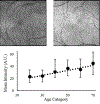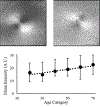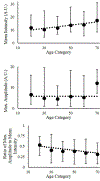Near-infrared polarimetric imaging and changes associated with normative aging
- PMID: 30183002
- PMCID: PMC6640646
- DOI: 10.1364/JOSAA.35.001487
Near-infrared polarimetric imaging and changes associated with normative aging
Abstract
With aging, the human retina undergoes cell death and additional structural changes that can increase scattered light. We quantified the effect of normative aging on multiply scattered light returning from the human fundus. As expected, there was an increase of multiply scattered light associated with aging, and this is consistent with the histological changes that occur in the fundus of individuals before developing age-related macular degeneration. This increase in scattered light with aging cannot be attributed to retinal reflectivity, anterior segment scatter, or pupil diameter.
Figures













Similar articles
-
CHANGES OF OUTER RETINAL THICKNESS WITH INCREASING AGE IN NORMAL EYES AND IN NORMAL FELLOW EYES OF PATIENTS WITH UNILATERAL AGE-RELATED MACULAR DEGENERATION.Retina. 2017 Jan;37(1):47-52. doi: 10.1097/IAE.0000000000001131. Retina. 2017. PMID: 27347643
-
CLINICOPATHOLOGIC CORRELATION OF GEOGRAPHIC ATROPHY SECONDARY TO AGE-RELATED MACULAR DEGENERATION.Retina. 2019 Apr;39(4):802-816. doi: 10.1097/IAE.0000000000002461. Retina. 2019. PMID: 30839495 Free PMC article.
-
Infrared imaging of sub-retinal structures in the human ocular fundus.Vision Res. 1996 Jan;36(1):191-205. doi: 10.1016/0042-6989(95)00100-e. Vision Res. 1996. PMID: 8746253
-
The aging of the retina.Exp Gerontol. 2003 Aug;38(8):825-31. doi: 10.1016/s0531-5565(03)00093-7. Exp Gerontol. 2003. PMID: 12915204 Review.
-
Prognostic implications of imaging in atrophic macular degeneration and its use in clinical practice and clinical trial design.Clin Exp Ophthalmol. 2016 Jul;44(5):410-21. doi: 10.1111/ceo.12671. Epub 2016 Jan 26. Clin Exp Ophthalmol. 2016. PMID: 26468964 Review.
Cited by
-
Three-Dimensional Distribution Of Fundus Depolarization and Associating Factors Measured Using Polarization-Sensitive Optical Coherence Tomography.Transl Vis Sci Technol. 2021 Feb 5;10(2):30. doi: 10.1167/tvst.10.2.30. Transl Vis Sci Technol. 2021. PMID: 34003915 Free PMC article.
-
Cones in ageing and harsh environments: the neural economy hypothesis.Ophthalmic Physiol Opt. 2020 Mar;40(2):88-116. doi: 10.1111/opo.12670. Epub 2020 Feb 4. Ophthalmic Physiol Opt. 2020. PMID: 32017191 Free PMC article. Review.
-
NONCONFOCAL ULTRA-WIDEFIELD SCANNING LASER OPHTHALMOSCOPY: Polarization Artifacts and Diabetic Macular Edema.Retina. 2020 Jul;40(7):1374-1378. doi: 10.1097/IAE.0000000000002588. Retina. 2020. PMID: 31181039 Free PMC article.
References
-
- Sarks JP, Sarks SH, and Killingsworth MC. “Evolution of geographic atrophy of the retinal pigment epithelium,” Eye 2(5), 552–577 (1988). - PubMed
-
- Elsner AE, Burns SA, Beausencourt E, and Weiter JJ. “Foveal cone photopigment distribution: small alterations associated with macular pigment distribution,” Invest Ophthalmol Vis Sci 39, 2394–2404 (1998). - PubMed
MeSH terms
Grants and funding
LinkOut - more resources
Full Text Sources
Other Literature Sources
Medical
Research Materials

